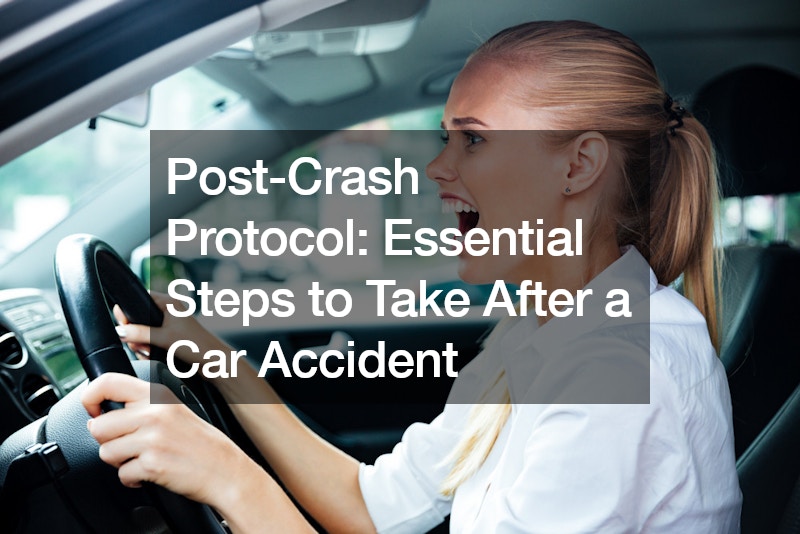Car accidents can happen unexpectedly, leaving individuals feeling overwhelmed and unsure of what steps to take next. However, knowing what to do in the aftermath of a crash is crucial for ensuring everyone’s safety and protecting your rights. In this comprehensive guide, we’ll outline the essential steps to take after a car accident to navigate the situation effectively.
1. Assess the Situation
Assessing the situation promptly following a car accident is crucial. Take a moment to evaluate the scene carefully, ensuring safety for everyone involved. Here’s what you can do:
Check for Injuries: First and foremost, assess yourself and others for any injuries. This includes visible injuries like cuts and bruises, as well as potential internal injuries that may not be immediately apparent. For example, someone might have sustained a concussion or whiplash, which may not manifest symptoms right away.
Evaluate Vehicle Damage: After ensuring everyone’s safety, inspect the vehicles involved in the accident to determine the extent of damage. Look for visible signs of damage such as dents, scratches, or broken lights. Additionally, check for any leaking fluids or other mechanical issues that may have occurred as a result of the collision.
Stay Calm and Focused: It’s natural to feel shaken after a car accident, but it’s essential to remain calm and focused. Keeping a level head will enable you to handle the situation more efficiently and make rational decisions. Take deep breaths and focus on the tasks at hand, such as checking for injuries and exchanging information with other parties involved.
2. Move to a Safe Location
Moving vehicles to a safe location following a car accident is paramount to prevent further harm and ensure the well-being of everyone involved. Here are essential steps to take:
Clear the Road: If it’s safe to do so, move the vehicles involved in the accident out of the flow of traffic. This prevents additional accidents and allows traffic to continue flowing smoothly. Utilize hazard lights to signal to other drivers that your vehicle is in distress and needs assistance.
Set Up Warning Signals: Place warning triangles or cones behind your vehicle to alert approaching drivers of the accident scene. This increases visibility and reduces the risk of secondary accidents. Additionally, consider using flares or reflective markers if they are available.
Consider Roadside Assistance: If your vehicle is disabled or unsafe to drive, consider contacting roadside assistance for assistance. They can help tow your vehicle to a repair facility or provide on-site assistance, depending on the extent of the damage.
Prioritize Safety: Above all, prioritize safety for yourself, passengers, and other road users. Avoid standing in the path of oncoming traffic and keep a safe distance from the roadway while waiting for assistance. If possible, move to a nearby sidewalk or designated safe area until help arrives.
By promptly moving vehicles to a safe location and signaling to other drivers, you can mitigate the risk of further accidents and ensure the safety of everyone involved in the aftermath of a car accident. Remember to prioritize safety and seek assistance from roadside assistance or towing services if needed.
3. Contact Emergency Services

Contacting emergency services promptly after a car accident is crucial to ensure the safety of everyone involved and to initiate the appropriate response to the situation. Here’s why it’s essential and how to do it effectively:
Safety First: The primary concern after a car accident is the well-being of everyone involved. If anyone is injured, whether it’s yourself, passengers, or the occupants of other vehicles, immediate medical attention may be necessary. By contacting emergency services, you can ensure that trained professionals are dispatched to the scene to provide medical assistance as needed.
Police Assistance: In addition to medical assistance, contacting emergency services involves alerting the police to the accident. Having law enforcement officers at the scene allows for an official report to be filed, which can be crucial for insurance claims and legal proceedings. The police can also help manage traffic flow and ensure the safety of the accident scene.
Accurate Information: When contacting emergency services, it’s essential to provide accurate information about the location and nature of the accident. Be prepared to provide details such as the exact location of the accident, the number of vehicles involved, any injuries sustained, and any hazards present at the scene. Providing clear and concise information helps emergency responders assess the situation quickly and dispatch the appropriate resources.
Requesting Medical Assistance: If anyone involved in the accident is injured, it’s vital to request medical assistance promptly. Even injuries that seem to be minor can escalate if left untreated, so err on the side of caution and request medical attention for anyone who may need it. Emergency medical responders can provide on-site treatment and transport injured individuals to the hospital if necessary. In cases of serious injuries or uncertainty about the extent of injuries sustained, do not hesitate to seek evaluation and treatment at local emergency rooms. These facilities are equipped to handle a wide range of medical emergencies and can provide timely and appropriate care to accident victims.
4. Exchange Information
After a car accident, exchanging information with the other parties involved is critical for smooth resolution of insurance claims and any potential legal proceedings. By exchanging comprehensive information with all parties involved and any witnesses, you ensure that you have the necessary documentation to support your auto insurance claim and protect your rights in case of any legal disputes. Here’s what you should gather:
Contact Information: Exchange names, phone numbers, addresses, and email addresses with the other driver(s) involved in the accident. This ensures that you can communicate with them or their insurance company as needed throughout the claims process.
Insurance Information: Obtain the insurance company name and policy number of the other driver(s) involved. Likewise, provide them with your insurance details. This information is essential for filing insurance claims and determining liability for the accident.
Witness Information: If there were witnesses to the accident, gather their names and contact information as well. Witness testimony can provide crucial evidence in case of disputes over fault or liability. Be sure to ask witnesses if they are willing to provide a statement or testify if necessary.
5. Document the Scene
Documenting the accident scene thoroughly is essential for providing evidence to support your insurance claim and potentially your legal case. By documenting the accident scene comprehensively, you provide tangible evidence to support your insurance claim and help establish the facts of the accident. This can be invaluable in resolving disputes and ensuring that you receive fair compensation for any damages or injuries sustained. Here’s how to document the scene effectively:
Photographs: Take photos of the accident scene from multiple angles, capturing the vehicles involved, the surrounding area, and any relevant details. Include close-up shots of the vehicle damage, skid marks on the road, traffic signs, and any visible injuries.
Road Conditions: Note the condition of the road at the time of the accident, including weather conditions, visibility, and any hazards such as potholes or debris. Documenting these factors can help establish the circumstances of the accident and determine liability.
Signage and Landmarks: Take photographs of any relevant signage or landmarks near the accident scene, as they may provide important context for understanding what happened. This could include street signs, traffic signals, or nearby buildings.
6. File a Police Report

Filing a police report after a car accident, regardless of its apparent severity, holds significant importance. This official documentation serves multiple purposes, especially in navigating insurance claims and legal proceedings. Here’s why filing a police report is essential and how to handle it effectively:
Official Documentation: A police report provides an official record of the accident, documenting key details such as the date, time, and location of the incident, as well as the parties involved. This documentation holds weight in insurance claims and legal matters, serving as objective evidence of what transpired.
Insurance Claims: Insurance companies often require a police report to process claims efficiently. It helps establish the facts of the accident and determine liability, aiding in the fair resolution of claims. Without a police report, insurers may face challenges in assessing the validity of claims and may be more inclined to dispute them.
Legal Matters: In the event of disputes or legal proceedings arising from the accident, a police report can be invaluable. It provides a detailed account of the accident from an impartial perspective, which can strengthen your case if you need to pursue legal action. Personal injury law recognizes the importance of police reports in establishing liability and seeking compensation for injuries sustained in car accidents.
Accurate Information: When filing a police report, provide the responding officer with accurate information about the accident. Be thorough in recounting what occurred, including details such as the sequence of events leading up to the accident, any contributing factors, and any injuries sustained. Cooperation with law enforcement is crucial, as it ensures that the report accurately reflects the circumstances of the accident.
Cooperate Fully: Cooperate fully with the responding officer’s investigation, providing any additional information or documentation they may request. This may include sharing contact information for witnesses, providing proof of insurance, or allowing the officer to inspect the vehicles involved. By cooperating with the investigation, you help ensure that the police report is comprehensive and accurate.
7. Notify Your Insurance Company

Notifying your car insurance agency promptly after a car accident is crucial to kickstart the claims process and ensure timely assistance. Here’s how to handle it effectively:
Timely Notification: Contact your car insurance agency as soon as possible after the accident occurs. Prompt notification allows them to begin processing your claim promptly and provide any necessary guidance or assistance. Delaying notification could lead to complications in the claims process and potential delays in receiving compensation for damages.
Provide Comprehensive Information: When reporting the accident to your car insurance agency, provide them with all relevant information and documentation. This includes details such as the date, time, and location of the accident, as well as the parties involved and any injuries sustained. Additionally, provide copies of the police report and any photographs taken at the scene to support your claim.
Cooperation is Key: Be prepared to answer any questions your car insurance agent may have about the accident. They may inquire about the circumstances surrounding the collision, the extent of damages to your vehicle, and any injuries sustained. Providing clear and concise answers helps expedite the claims process and ensures that your insurance agency has all the information they need to assess your claim accurately.
Additional Assistance: In some cases, your car insurance agency may offer additional assistance beyond processing your claim. For example, they may provide recommendations for reputable car towing companies to transport your vehicle to a repair facility. Taking advantage of these services can streamline the process of getting your vehicle repaired and back on the road.
Follow-Up Communication: Stay in communication with your car insurance agency throughout the claims process. They may require additional information or documentation as they investigate your claim, so be responsive to any requests they make. Keeping open lines of communication ensures that your claim progresses smoothly and that any issues are addressed promptly.
8. Consider Legal Representation

Considering legal representation after a car accident, particularly if it resulted in significant injuries or involves intricate legal matters, is a prudent step to safeguard your interests. Here’s a comprehensive approach:
Assessing the Severity: Evaluate the severity of the accident and its consequences, particularly regarding injuries sustained. If the accident resulted in severe injuries, long-term disabilities, or fatalities, or if liability issues are complex, seeking legal counsel becomes imperative.
Understanding Legal Implications: Recognize the legal implications of the accident. Complexities may arise if fault is disputed, multiple parties are involved, or if there are questions regarding insurance coverage and compensation. Personal injury attorneys specialize in navigating such legal complexities and ensuring your rights are protected.
Expert Guidance: Personal injury attorneys possess the expertise and experience necessary to navigate the legal intricacies of car accident cases. They can provide invaluable guidance on the steps to take, legal options available, and potential outcomes. Their knowledge of relevant laws and precedents equips them to build a strong case on your behalf.
Protecting Your Rights: One of the primary roles of personal injury attorneys is to protect your rights throughout the legal process. They advocate for your best interests, negotiate with insurance companies, and, if necessary, represent you in court proceedings. Their goal is to secure fair compensation for your injuries, damages, and losses.
Initial Consultation: Schedule an initial consultation with prospective personal injury attorneys to discuss your case in detail. During this meeting, provide them with all relevant information, including details of the accident, injuries sustained, and any documentation you have. Use this opportunity to assess their experience, expertise, and approach to handling your case.
9. Follow Through on Repairs
Following through on car repairs after a car accident is vital to ensure the safety and roadworthiness of your vehicle. Here’s how to approach this step effectively:
Prompt Inspection and Repair: Arrange for your vehicle to be professionally inspected and repaired without delay. Even seemingly minor damage can escalate if left unattended, potentially compromising the structural integrity or safety features of your vehicle. Engage the services of reputable auto collision repair shops to assess and address any damage sustained in the accident promptly.
Risk of Delay: Delaying repairs following a car accident can exacerbate existing damage and create safety hazards on the road. For example, a dent or misalignment in the frame may compromise the vehicle’s structural integrity, increasing the risk of further damage or injury in the event of another accident. Addressing these issues promptly mitigates potential risks and ensures the vehicle’s safe operation.
Obtain Multiple Estimates: Obtain repair estimates from several reputable auto collision repair shops to ensure you receive fair pricing and quality service. Compare estimates carefully, considering factors such as the extent of repairs needed, the expertise of the repair technicians, and the warranty offered on parts and labor. Select a repair shop that offers competitive pricing and a reputation for excellence in craftsmanship.
Documentation: Keep thorough records of all repairs made to your vehicle, including invoices, receipts, and detailed descriptions of the work performed. This documentation serves as evidence of the repairs conducted and can be valuable for insurance purposes or future reference. Additionally, retain any warranty information provided by the repair shop for your records.
By promptly addressing repairs with reputable auto collision repair shops, you safeguard the safety and integrity of your vehicle while mitigating the risk of further damage or safety hazards.
In Closing
While no one wants to experience a car accident, being prepared and knowing what steps to take can help alleviate some of the stress and uncertainty. By following these essential steps after a car accident, you can ensure everyone’s safety, protect your rights, and navigate the aftermath of the crash more effectively. Remember to stay calm, seek assistance when needed, and prioritize your health and well-being above all else.



